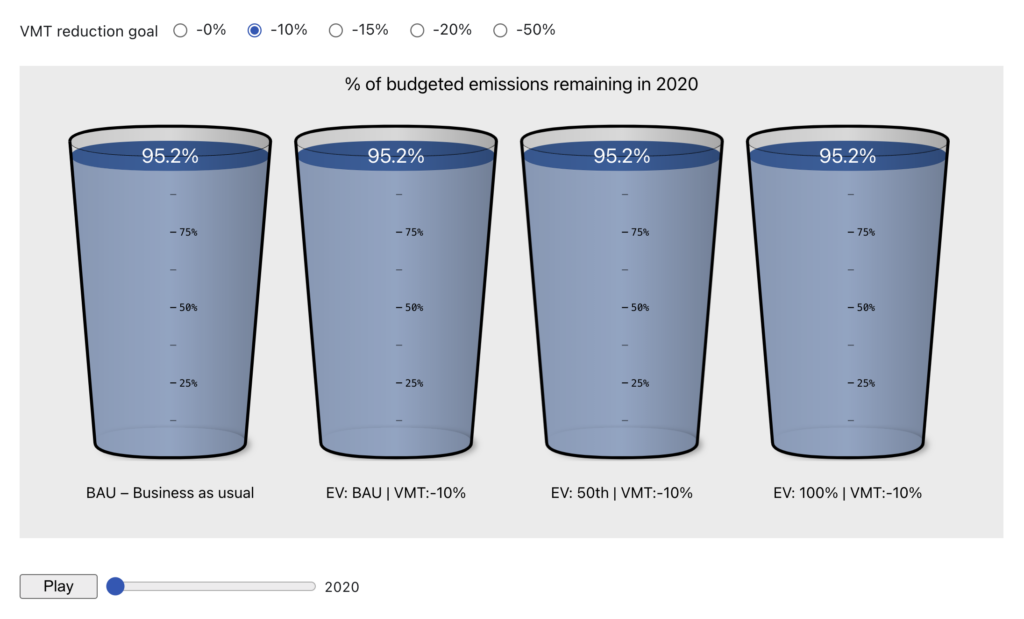New tool to visualize transportation emissions—and how much we have left
There is a limited amount of carbon emissions the US transportation sector can emit before the most extreme effects of climate change take hold. Our new tool shows when we might bottom out, locking in the negative consequences of climate change.

Transportation’s role in emissions
According to the EPA, transportation was responsible for more greenhouse gas (GHG) emissions than any other sector of the economy in 2022—more than the agriculture, commercial, and residential sectors combined. Light-duty vehicles, such as the cars we use for daily trips, are responsible for 57 percent of these emissions—over 660 million tonnes of CO2-equivalent annually.
We have a finite amount of CO2 to emit to avoid the worst effects of climate change, and if the transportation sector continues to produce emissions at our current rate, even as we push for electric vehicle adoption, the damage will have already been done.
Where we stand: The carbon countdown
When looking exclusively at the transportation sector, a conservative estimate suggests that as of 2020, only 26,000 million tonnes of CO2 emissions remain if we are to stay within 1.5°C of warming. Our new tool illustrates that if we continue to proceed with a business-as-usual (BAU) approach, we will exceed our budgeted transportation emissions by 2041—or by 2044, even with 50 percent EV adoption.
CO2 emissions from transportation must not exceed available limits. If we exceed our carbon budget at any point—even if the US ultimately achieves net-zero emissions—we will lock in global warming beyond 1.5°C, making future mitigation efforts moot. The consequences of delay will be felt for generations.
We can only realistically avert the worst effects by achieving the lofty goals of 1) achieving 100 percent EV adoption by 2040 or 2) getting halfway to 100% EV adoption while cutting people’s vehicle miles traveled (VMT) in half per capita, which will we reduce emissions enough to prevent catastrophic warming.
Check out the tool
This tool looks at scenarios exploring expected emissions and when the transportation sector will meet and surpass no-turning-back levels for 1.5°C of warming, even with different levels of VMT-reduction and electric vehicle adoption.
Our tool uses a business-as-usual model to evaluate when we’ll run out of emissions. Our new report, Fueling the Crisis, finds that transportation projects funded by the 2021 infrastructure law are expected to increase emissions by an additional 77 million metric tonnes of CO2 emissions over what would have occurred without these investments due to VMT-increasing projects—further locking us into a trajectory that exceeds out carbon budget.
Transportation is responsible for more GHG emissions than any other sector of the economy. Why don’t we start acting like it?
For many, the only answer to reducing transportation emissions has been to transition to electric vehicles—but continue to invest in a system that requires more driving and more vehicles to reach essential needs. The US government set aside $7.5 billion of funds from the IIJA to develop EV charging infrastructure (a fraction of what has already been spent on emissions-increasing projects), and the Inflation Reduction Act has created dozens of tax credits and programs to help support the creation of a competitive electric automotive industry to compete with Chinese manufacturers who have already mastered cheap EVs at scale.
Electrifying the vehicle fleet is essential to decarbonizing the transportation system. But it is insufficient. Even as we have seen support from governments and an industry committed to the change, the average vehicle on the road today is over a decade old and increasing in age. Many combustion engine vehicles, which made up 84 percent of vehicles sold in 2023, will, by all indications, be on the road well into the 2040s.
If we electrify on time, but in the meantime, people continue to drive further, our transportation emissions will rise too quickly, and we will still exceed our carbon budget. And we’re far from on track currently: the EV transition appears to be taking longer than hoped and the transportation system we are building will force people to drive more often and for longer trips than ever before.
The way forward
To decarbonize transportation, we need aggressive EV adoption and investments in walking, biking, and transit infrastructure.
The main barrier to solving this issue is not fiscal but political, driven by leaders and bureaucrats whose imaginations have been limited by unrealistic models, unscientific standards, and outdated assumptions about people. With the IIJA set to expire in 2026 and the next transportation reauthorization facing a funding crisis, it is essential that our nation’s leaders modernize the approach to funding transportation projects.
Thank you to the Rocky Mountain Institute for their support of the tool, which pulls assumptions from RMI’s Smarter MODES calculator. Their calculator’s methodology can be found here.



